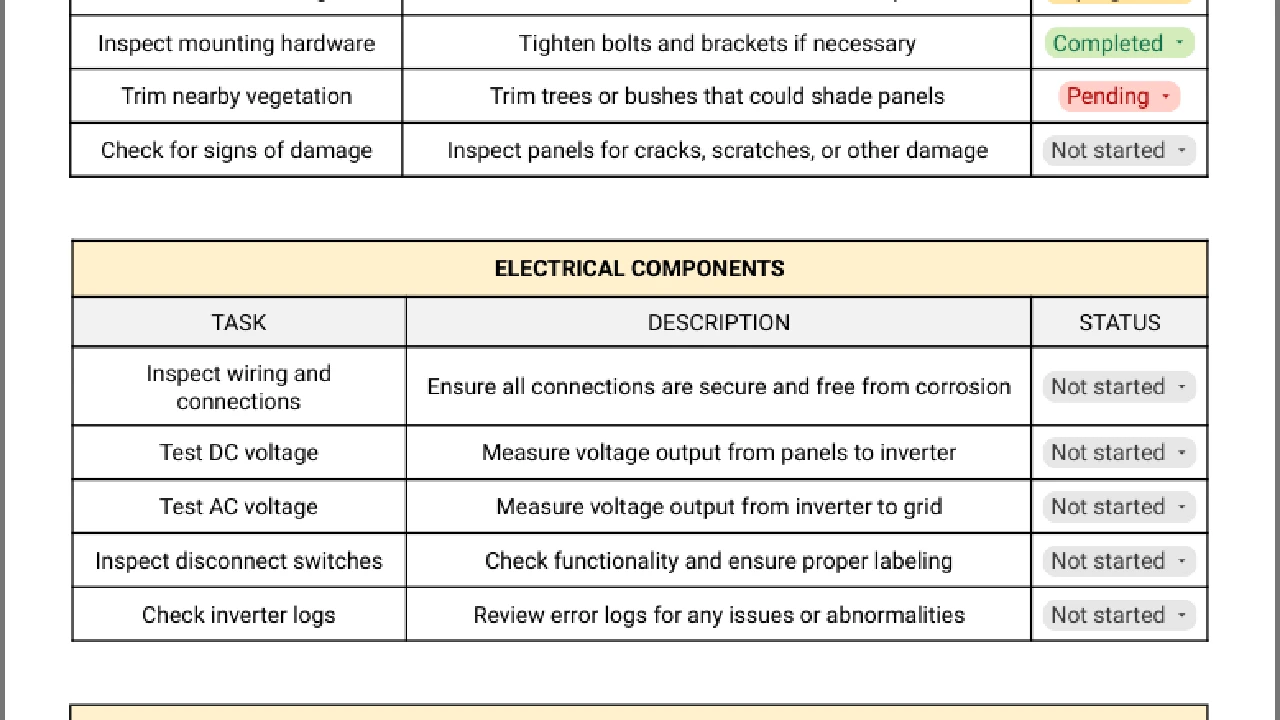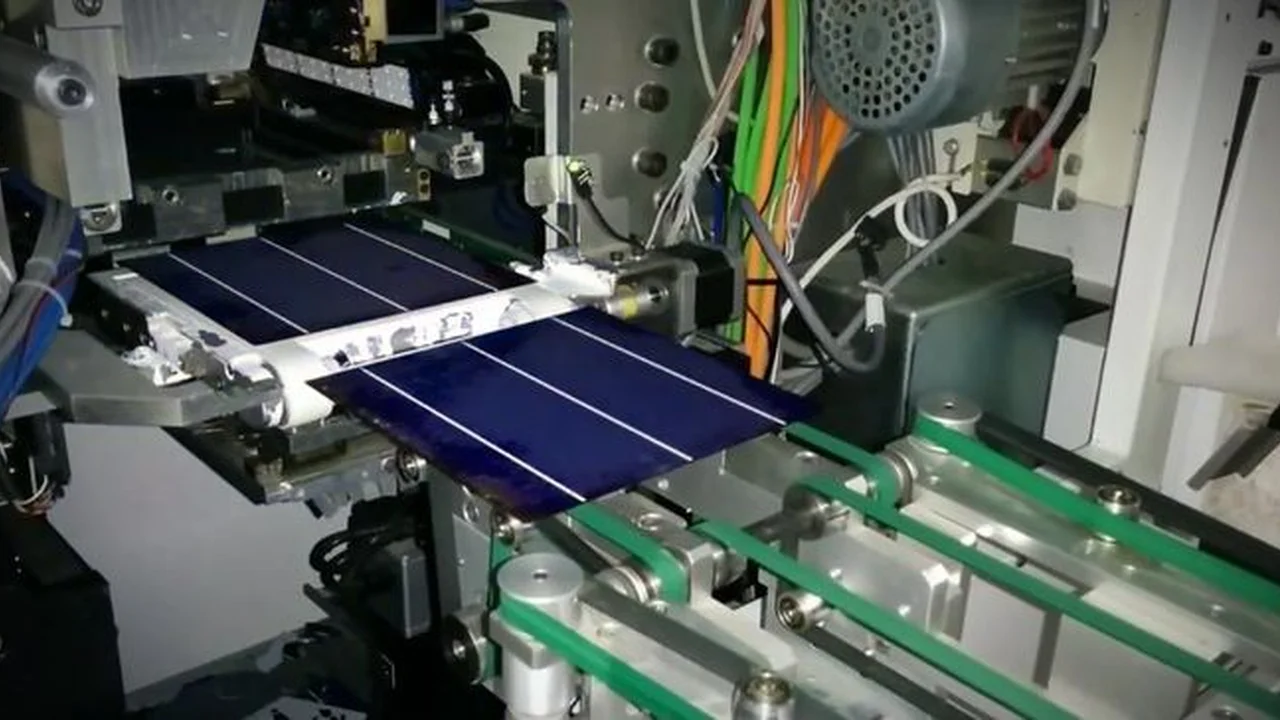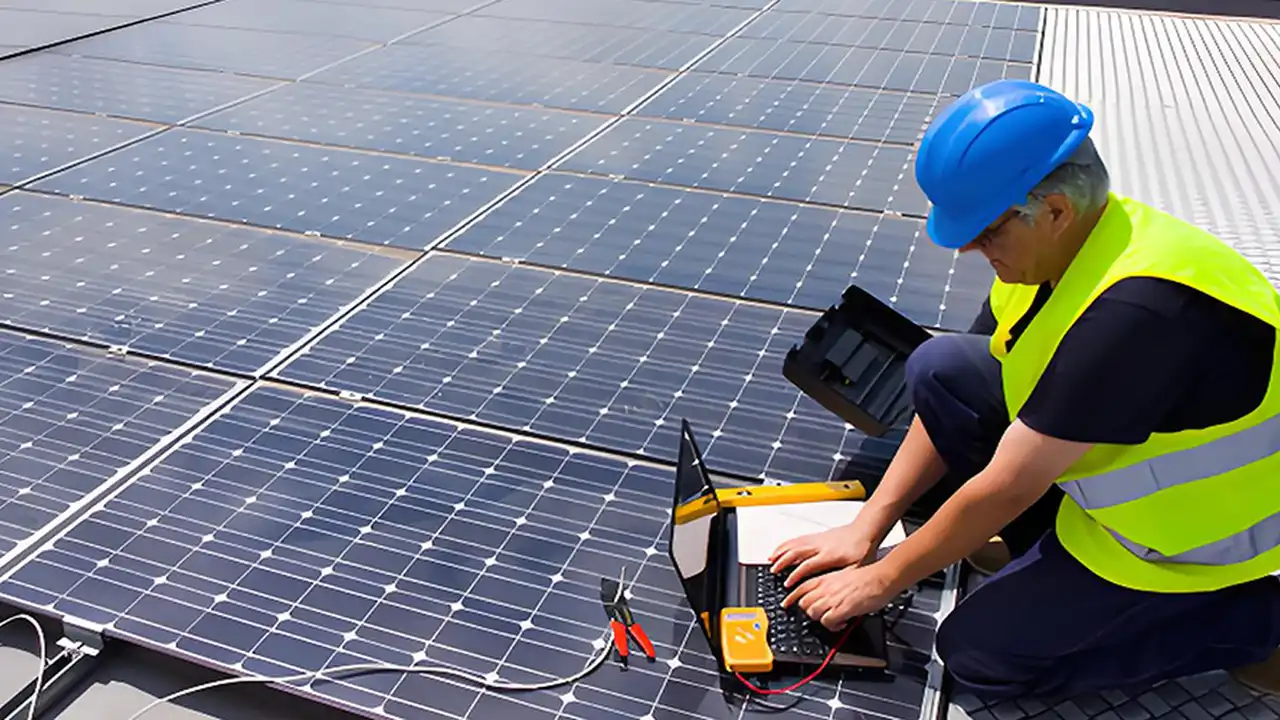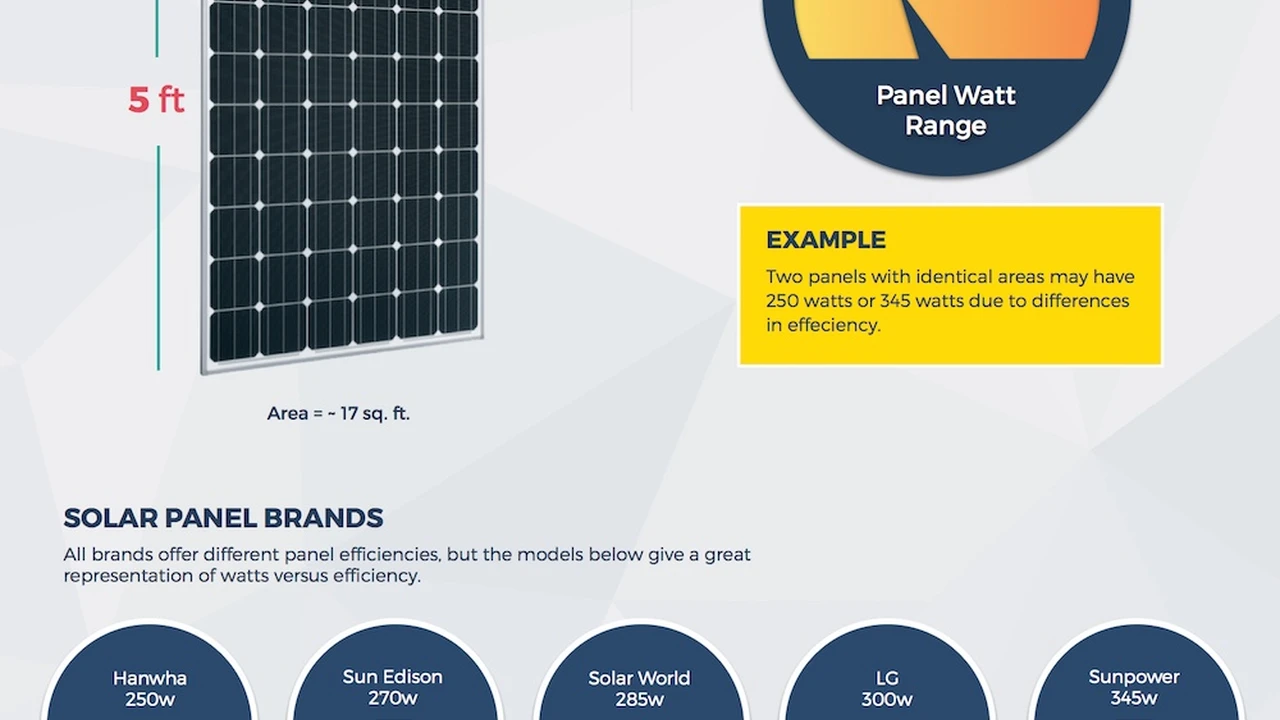Solar Panel Maintenance Checklist: Ensuring Long-Term Performance

Understanding the Importance of Solar Panel Maintenance for Optimal Performance
Alright, so you've invested in solar panels – smart move! You're harnessing the power of the sun and saving some serious cash. But just like your car or your house, your solar panels need a little TLC to keep them running smoothly. Neglecting maintenance can lead to reduced efficiency, costly repairs, and a shorter lifespan for your system. Think of it like this: a clean solar panel is a happy solar panel, and a happy solar panel means more energy and more savings for you!
Solar Panel Cleaning Techniques: DIY vs Professional Cleaning Services
Now, let's talk cleaning. You've got two main options: DIY or hiring a pro. DIY is definitely cheaper, but it requires some elbow grease and a bit of know-how. Professional cleaning services will cost you more, but they'll handle everything for you and often have specialized equipment and expertise. Let's break it down:
DIY Solar Panel Cleaning: A Step-by-Step Guide for Homeowners
If you're the DIY type, here's what you'll need:
- Soft Brush: Avoid anything abrasive that could scratch the panels. A soft-bristled brush attached to an extension pole is ideal.
- Hose with a Spray Nozzle: Use a gentle spray setting. High pressure can damage the panels.
- Mild Soap (Optional): If your panels are really dirty, you can use a mild, non-abrasive soap specifically designed for solar panels. Avoid harsh chemicals or detergents. Dish soap is generally okay in a very diluted form.
- Water: Use clean water, preferably deionized or filtered water to avoid mineral deposits that can leave spots.
The Cleaning Process:
- Safety First! Turn off your solar panel system at the breaker box before cleaning. This is especially important if you're working on a roof. Also, avoid cleaning during the hottest part of the day, as the panels will be hot and the water will evaporate too quickly, leaving streaks.
- Rinse: Start by rinsing the panels with water to remove loose dirt and debris.
- Wash (If Needed): If the panels are still dirty, gently scrub them with the soft brush and soapy water.
- Rinse Again: Rinse thoroughly with clean water to remove all traces of soap.
- Dry (Optional): You can let the panels air dry, or use a squeegee or microfiber cloth to dry them and prevent water spots.
Professional Solar Panel Cleaning: When to Call in the Experts
If you're not comfortable cleaning your solar panels yourself, or if you have a large or complex system, hiring a professional cleaning service is a good idea. They have the equipment, experience, and insurance to do the job safely and effectively.
Benefits of Professional Cleaning:
- Safety: Professionals are trained to work safely on roofs and around electrical equipment.
- Efficiency: They have specialized equipment and cleaning solutions that can remove even the toughest dirt and grime.
- Thoroughness: They'll clean every nook and cranny of your panels, ensuring optimal performance.
- Convenience: You don't have to lift a finger!
Solar Panel Inspection Checklist: Identifying Potential Problems Early
Regular inspections are crucial for catching potential problems before they become major headaches. Here's what to look for:
Visual Inspection: Checking for Cracks, Delamination, and Discoloration
Visually inspect your panels for any signs of damage, such as:
- Cracks: Even small cracks can reduce the efficiency of your panels and allow moisture to enter.
- Delamination: This is when the layers of the panel start to separate.
- Discoloration: Yellowing or browning of the panels can indicate overheating or other problems.
- Bird Droppings: Bird droppings can block sunlight and reduce efficiency.
- Debris: Leaves, branches, and other debris can also block sunlight.
Electrical Inspection: Monitoring Voltage, Current, and Inverter Performance
Monitor the performance of your system by checking the voltage, current, and inverter performance. You can usually do this through your inverter's monitoring system or by using a multimeter.
- Voltage: Check the voltage of each panel to make sure it's within the expected range.
- Current: Check the current of each panel to make sure it's within the expected range.
- Inverter Performance: Monitor the inverter's performance to make sure it's converting DC power to AC power efficiently.
Solar Panel Repair and Troubleshooting: Addressing Common Issues
Even with regular maintenance, you may still encounter some problems with your solar panels. Here are some common issues and how to address them:
Hot Spots: Identifying and Resolving Overheating Problems
Hot spots are areas of a solar panel that are significantly hotter than the surrounding areas. They can be caused by shading, dirt, or manufacturing defects. Hot spots can reduce the efficiency of your panels and even cause damage.
How to identify hot spots:
- Visual Inspection: Look for areas of discoloration or damage.
- Infrared Camera: Use an infrared camera to identify areas of high temperature.
How to resolve hot spots:
- Remove Shading: Trim trees or remove other obstructions that are shading the panels.
- Clean the Panels: Clean the panels to remove dirt and debris.
- Replace Damaged Panels: If the hot spot is caused by a manufacturing defect, you may need to replace the panel.
Wiring Issues: Inspecting and Repairing Damaged Cables and Connections
Check the wiring for any signs of damage, such as:
- Cracked or frayed wires.
- Loose connections.
- Corrosion.
If you find any damaged wiring, it's important to repair it immediately. You can usually do this yourself with some basic tools and supplies, but if you're not comfortable working with electricity, it's best to hire a professional.
Inverter Problems: Diagnosing and Repairing Inverter Malfunctions
The inverter is a critical component of your solar panel system, as it converts DC power to AC power. If your inverter malfunctions, your system will stop producing electricity.
Common inverter problems:
- Overheating.
- Tripped circuit breakers.
- Error codes.
If you're experiencing problems with your inverter, consult your inverter's manual or contact a qualified electrician.
Recommended Solar Panel Maintenance Products and Tools
Okay, let's get into some product recommendations. Here are a few things that can make your solar panel maintenance a whole lot easier:
Cleaning Solutions: Comparing Different Solar Panel Cleaning Soaps
- Dawn Dish Soap (Diluted): A classic for a reason. It's gentle, effective, and readily available. Just make sure to dilute it *heavily* – a few drops in a bucket of water is all you need. Price: Around $2-3 per bottle. Use Case: Light cleaning, removing dust and pollen.
- Solar Panel Cleaning Soap by ShineWiz: Specifically formulated for solar panels, this soap is biodegradable and won't damage the panels. Price: Around $20 per gallon. Use Case: Heavier cleaning, removing bird droppings and stubborn grime.
- Deionized Water System: This isn't a soap, but it's crucial for streak-free cleaning. Deionized water removes minerals that can leave spots. Price: Varies widely, from $50 for a small filter to $500+ for a whole-house system. Use Case: Final rinse to prevent water spots.
Cleaning Tools: Choosing the Right Brushes, Squeegees, and Extension Poles
- Soft-Bristled Brush with Extension Pole: Essential for reaching all areas of your panels. Look for a brush with soft bristles that won't scratch the panels. Price: Around $30-50. Use Case: Scrubbing away dirt and grime.
- Squeegee with Rubber Blade: Helps to remove excess water and prevent water spots. Price: Around $10-20. Use Case: Drying the panels after cleaning.
- Telescoping Extension Pole: Allows you to reach even the highest panels without having to climb on the roof. Price: Around $50-100. Use Case: Reaching high panels safely.
Inspection Tools: Multimeters, Infrared Thermometers, and Voltage Testers
- Multimeter: A versatile tool for measuring voltage, current, and resistance. Price: Around $20-100. Use Case: Checking the electrical performance of your panels.
- Infrared Thermometer (IR Thermometer): Allows you to identify hot spots on your panels. Price: Around $50-200. Use Case: Diagnosing overheating problems.
- Voltage Tester: A simple tool for checking for voltage in electrical circuits. Price: Around $10-30. Use Case: Ensuring safety when working with electrical components.
Cost of Solar Panel Maintenance: Balancing Prevention and Repair
Let's talk money. How much will it cost to keep your solar panels in tip-top shape?
DIY Maintenance Costs: Estimating Expenses for Cleaning and Minor Repairs
If you're going the DIY route, your costs will be relatively low. You'll need to factor in the cost of cleaning supplies, tools, and any replacement parts you may need.
Estimated DIY Costs:
- Cleaning Supplies: $20-50 per year.
- Tools: $50-100 (one-time investment).
- Replacement Parts: Varies depending on the part, but typically less than $100 per year.
Professional Maintenance Costs: Comparing Service Packages and Pricing
Professional maintenance services will cost more, but they'll also save you time and effort. Service packages typically include cleaning, inspection, and minor repairs.
Estimated Professional Costs:
- Cleaning: $150-300 per cleaning (depending on the size and complexity of your system).
- Inspection: $100-200 per inspection.
- Maintenance Packages: $300-500 per year.
Extending the Lifespan of Your Solar Panels: Proactive Maintenance Strategies
The best way to save money on solar panel maintenance is to be proactive. By following a regular maintenance schedule and addressing problems early, you can extend the lifespan of your panels and avoid costly repairs.
Regular Cleaning Schedule: Determining the Optimal Frequency for Your Location
How often you need to clean your solar panels depends on your location and the amount of dirt and debris they're exposed to. In general, you should clean your panels at least once or twice a year. If you live in a dusty or polluted area, you may need to clean them more often.
Preventative Measures: Protecting Your Panels from Damage and Degradation
There are several things you can do to protect your panels from damage and degradation:
- Trim Trees: Trim trees or remove other obstructions that are shading the panels.
- Install Bird Deterrents: Install bird deterrents to prevent birds from nesting on your panels.
- Check for Loose Connections: Regularly check for loose connections and tighten them as needed.
Solar Panel Warranty Coverage: Understanding Your Rights and Responsibilities
Your solar panels are likely covered by a warranty. Be sure to read the warranty carefully to understand your rights and responsibilities.
Warranty Types: Performance Guarantees, Equipment Warranties, and Workmanship Warranties
There are typically three types of warranties for solar panels:
- Performance Guarantees: Guarantee that the panels will produce a certain amount of electricity over a certain period of time.
- Equipment Warranties: Cover the cost of replacing defective panels.
- Workmanship Warranties: Cover the cost of repairing or replacing improperly installed panels.
Claiming Warranty Coverage: Navigating the Warranty Process
If you need to claim warranty coverage, follow these steps:
- Contact the Installer or Manufacturer: Contact the company that installed your panels or the manufacturer of the panels.
- Provide Documentation: Provide documentation of the problem, such as photos or videos.
- Follow Instructions: Follow the instructions provided by the installer or manufacturer.
:max_bytes(150000):strip_icc()/277019-baked-pork-chops-with-cream-of-mushroom-soup-DDMFS-beauty-4x3-BG-7505-5762b731cf30447d9cbbbbbf387beafa.jpg)





